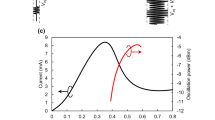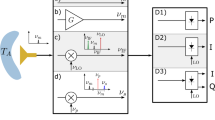Abstract
Modern communication systems rely on efficient quadrature amplitude modulation formats that encode information on both the amplitude and phase of an electromagnetic carrier. Coherent detection of such signals typically requires complex receivers that contain a continuous-wave local oscillator as a phase reference and a mixer circuit for spectral down-conversion. In optical communications, the so-called Kramers–Kronig scheme has been demonstrated to simplify the receiver, reducing the hardware to a single photodiode1,2,3. In this approach, a local-oscillator tone is transmitted along with the signal, and the amplitude and phase of the complex signal envelope are digitally reconstructed from the photocurrent by exploiting their Kramers–Kronig-type relation4,5,6. Here, we transfer the Kramers–Kronig scheme to high-speed wireless communications at terahertz carrier frequencies. To this end, we generalize the approach to account for non-quadratic receiver characteristics and employ a Schottky-barrier diode as a nonlinear receiver element. Using 16-state quadrature amplitude modulation, we transmit a net data rate of 115 Gbit s−1 at a carrier frequency of 0.3 THz over a distance of 110 m.
This is a preview of subscription content, access via your institution
Access options
Access Nature and 54 other Nature Portfolio journals
Get Nature+, our best-value online-access subscription
$29.99 / 30 days
cancel any time
Subscribe to this journal
Receive 12 print issues and online access
$209.00 per year
only $17.42 per issue
Buy this article
- Purchase on Springer Link
- Instant access to full article PDF
Prices may be subject to local taxes which are calculated during checkout





Similar content being viewed by others
Data availability
The data that support the findings of this study are available from the corresponding author on reasonable request.
References
Mecozzi, A., Antonelli, C. & Shtaif, M. Kramers–Kronig coherent receiver. Optica 3, 1220–1227 (2016).
Zhong, K., Lu, C., Pak, A. & Lau, T. Digital signal processing for short-reach optical communications: a review of current technologies and future trends. J. Lightwave Technol. 36, 377–400 (2018).
Chen, X. et al. Kramers–Kronig receivers for 100 km datacenter interconnects. J. Lightwave Technol. 36, 79–89 (2018).
Voelcker, H. Demodulation of single-sideband signals via envelope detection. IEEE Trans. Commun. 14, 22–30 (1966).
Kramers, M. H. A. La diffusion de la lumière par les atomes. Atti Cong. Intern. Fis. 2, 545–557 (1927).
Kronig, R. de L. On the theory of the dispersion of X-rays. J. Opt. Soc. Am. 12, 547–557 (1926).
Nagatsuma, T., Ducournau, G. & Renaud, C. C. Advances in terahertz communications accelerated by photonics. Nat. Photon. 10, 371–379 (2016).
Ma, J. et al. Security and eavesdropping in terahertz wireless links. Nature 563, 89–93 (2018).
Kawanishi, T. THz and photonic seamless communications. J. Lightwave Technol. 37, 1671–1679 (2019).
Koenig, S. et al. Wireless sub-THz communication system with high data rate. Nat. Photon. 7, 977–981 (2013).
Puerta, R. et al. Single-carrier dual-polarization 328 Gb/s wireless transmission in a D-band millimeter wave 2 × 2 MU-MIMO radio-over-fiber system. J. Lightwave Technol. 36, 587–593 (2018).
Li, X. et al. 1 Tb/s millimeter-wave signal wireless delivery at D-band. J. Lightwave Technol. 37, 196–204 (2019).
Seeds, A. J., Shams, H., Fice, M. J. & Renaud, C. C. Terahertz photonics for wireless communications. J. Lightwave Technol. 33, 579–587 (2015).
Yu, X. et al. 160 Gbit/s photonics wireless transmission in the 300–500 GHz band. APL Photon. 1, 081301 (2016).
Kallfass, I. et al. 64 Gbit/s transmission over 850 m fixed wireless link at 240 GHz carrier frequency. J. Infrared Millim. Terahertz Waves 36, 221–233 (2015).
Ma, J., Shrestha, R., Moeller, L. & Mittleman, D. M. Invited article: channel performance for indoor and outdoor terahertz wireless links. APL Photon. 3, 051601 (2018).
Schneider, G. J., Murakowski, J. A., Schuetz, C. A., Shi, S. & Prather, D. W. Radiofrequency signal-generation system with over seven octaves of continuous tuning. Nat. Photon. 7, 118–122 (2013).
Carpintero, G. et al. Wireless data transmission at terahertz carrier waves generated from a hybrid InP-polymer dual tunable DBR laser photonic integrated circuit. Sci. Rep. 8, 3018 (2018).
Nagatsuma, T. & Carpintero, G. Recent progress and future prospect of photonics-enabled terahertz communications research. IEICE Trans. Electron. E98.C, 1060–1070 (2015).
Harter, T. et al. 110 m THz wireless transmission at 100 Gbit/s using a Kramers–Kronig Schottky barrier diode receiver. In Proc. 2018 European Conference on Optical Communication 1–3 (IEEE, 2018).
Rappaport, T. S. et al. Millimeter wave mobile communications for 5G cellular: it will work! IEEE Access 1, 335–349 (2013).
Andrews, J. G. et al. What will 5G be? IEEE J. Sel. Areas Commun. 32, 1065–1082 (2014).
Minimum Requirements Related to Technical Performance for IMT-2020 Radio Interface(s) Report No. M.2410-0 (ITU-R, 2017).
Latva-aho, M. & Leppänen, K. (eds) Key Drivers and Research Challenges for 6G Ubiquitous Wireless Intelligence (6G Flagship, Univ. Oulu, 2019).
Lowery, A. J., Wang, T. & Corcoran, B. Clipping-enhanced Kramers–Kronig receivers. In Proc. 2019 Optical Fiber Communications Conference and Exhibition M1H.2 (OSA, 2019).
Ito, H., Furuta, T., Muramoto, Y., Ito, T. & Ishibashi, T. Photonic millimetre- and sub-millimetre-wave generation using J-band rectangular-waveguide-output uni-travelling-carrier photodiode module. Electron. Lett. 42, 1424–1425 (2006).
Shoji, Y., Hamaguchi, K. & Ogawa, H. Millimeter-wave remote self-heterodyne system for extremely stable and low-cost broad-band signal transmission. IEEE Trans. Microw. Theory Tech. 50, 1458–1468 (2002).
Hermelo, M. F. et al. Spectral efficient 64-QAM-OFDM terahertz communication link. Opt. Express 25, 19360–19370 (2017).
Schmogrow, R. et al. Error vector magnitude as a performance measure for advanced modulation formats. IEEE Photon. Technol. Lett. 24, 61–63 (2012).
Schmogrow, R. et al. Corrections to ‘error vector magnitude as a performance measure for advanced modulation formats’. IEEE Photon. Technol. Lett. 24, 2198 (2012).
Smith, B. P., Farhood, A., Hunt, A., Kschischang, F. R. & Lodge, J. Staircase codes: FEC for 100 Gb/s OTN. J. Lightwave Technol. 30, 110–117 (2012).
Li, Z. et al. Digital linearization of direct-detection transceivers for spectrally efficient 100 Gb/s/λ WDM metro networking. J. Lightwave Technol. 36, 27–36 (2018).
Cai, Y. et al. FPGA investigation on error-floor performance of a concatenated staircase and Hamming code for 400G-ZR forward error correction. J. Lightwave Technol. 37, 188–195 (2019).
Essiambre, R.-J. et al. Capacity limits of optical fiber networks. J. Lightwave Technol. 28, 662–701 (2010).
IEEE Standard for High Data Rate Wireless Multi-Media Networks—Amendment 2: 100 Gb/s Wireless Switched Point-to-Point Physical Layer Standard No. 802.15.3d-2017 (IEEE, 2017).
Hesler, J., Hui, K. & Crowe, T. Ultrafast millimeter wave and THz envelope detectors for wireless communications. In Proc. 2012 International Topical Meeting on Microwave Photonics 93–94 (IEEE, 2012).
Hesler, J. L. & Crowe, T. W. NEP and responsivity of THz zero-bias Schottky diode detectors. In Proc. Joint 32nd International Conference on Infrared and Millimeter Waves and 15th International Conference on Terahertz Electronics 844–845 (IEEE, 2007).
Tessmann, A. et al. High-gain submillimeter-wave mHEMT amplifier MMICs. In Proc. 2010 MTT-S International Microwave Symposium 53–56 (IEEE, 2010).
Toll, J. S. Causality and the dispersion relation: logical foundations. Phys. Rev. 104, 1760–1770 (1956).
Füllner, C. et al. Complexity analysis of the Kramers–Kronig receiver. J. Lightwave Technol. 37, 4295–4307 (2019).
Li, Z. et al. Joint optimisation of resampling rate and carrier-to-signal power ratio in direct-detection Kramers–Kronig receivers. In Proc. 2017 European Conference on Optical Communication W2D.3 (IEEE, 2017).
Savory, S. J. Digital coherent optical receivers: algorithms and subsystems. IEEE J. Sel. Top. Quantum Electron. 16, 1164–1179 (2010).
Farrow, C. W. A continuously variable digital delay element. In Proc. 1988 International Symposium on Circuits and Systems 2641–2645 (IEEE, 1988).
Godard, D. N. Self-recovering equalization and carrier tracking in two-dimensional data communication system. IEEE Trans. Commun. 28, 1867–1875 (1980).
Pfau, T. & Hoffmann, S. Hardware-efficient coherent digital receiver concept with feedforward carrier recovery for M-QAM constellations. J. Lightwave Technol. 27, 989–999 (2009).
Randel, S. et al. All-electronic flexibly programmable 864 Gb/s single-carrier PDM-64-QAM. In Proc. 2014 Optical Fiber Communication Conference Th5C.8 (OSA, 2014).
Faruk, S. & Savory, S. J. Digital signal processing for coherent transceivers employing multilevel formats. J. Lightwave Technol. 35, 1125–1141 (2017).
Bo, T. & Kim, H. Kramers–Kronig receiver operable without digital upsampling. Opt. Express 26, 13810–13818 (2018).
Mecozzi, A., Antonelli, C. & Shtaif, M. Kramers–Kronig receivers. Adv. Opt. Photon. 11, 480–517 (2019).
Freude, W. et al. Quality metrics for optical signals: eye diagram, Q-factor, OSNR, EVM and BER. In Proc. 14th International Conference on Transparent Optical Networks 1–4 (IEEE, 2012).
Acknowledgements
This work was supported by the European Research Council (ERC consolidator grant ‘TeraSHAPE’, no. 773248), the Alfried Krupp von Bohlen und Halbach Foundation, the Helmholtz International Research School of Teratronics (HIRST) and the Karlsruhe School of Optics and Photonics (KSOP). The work relies on instrumentation funded by the European Regional Development Fund (ERDF, grant EFRE/FEIH_776267), the Deutsche Forschungsgemeinschaft (DFG; grants DFG/INST 121384/166-1 and DFG/INST 121384/167-1) and the Hector Stiftung (Hector Foundation).
Author information
Authors and Affiliations
Contributions
T.H., C.F. and C.K. developed the idea; J.L.H. developed and supplied the SBD; the experiments were performed by T.H. and C.F. with the support of J.N.K., S.U., J.L.S., M.B. and E.B.; algorithms for data generation and signal processing were implemented by T.H., C.F. and S.R.; the project was supervised by A.-S.M., W.F., S.R. and C.K.; the paper was written by T.H., C.F., W.F., S.R. and C.K.; all authors revised the paper.
Corresponding author
Ethics declarations
Competing interests
J.L.H. is chief technology officer of Virginia Diodes Inc., a company manufacturing and selling high-speed SBDs for terahertz signal processing. All other authors have no competing interests.
Additional information
Publisher’s note Springer Nature remains neutral with regard to jurisdictional claims in published maps and institutional affiliations.
Supplementary information
Supplementary Information
Supplementary Sections 1–10, Figs. 1–13 and Table 1.
Rights and permissions
About this article
Cite this article
Harter, T., Füllner, C., Kemal, J.N. et al. Generalized Kramers–Kronig receiver for coherent terahertz communications. Nat. Photonics 14, 601–606 (2020). https://doi.org/10.1038/s41566-020-0675-0
Received:
Accepted:
Published:
Issue Date:
DOI: https://doi.org/10.1038/s41566-020-0675-0
This article is cited by
-
High-performance terahertz modulators induced by substrate field in Te-based all-2D heterojunctions
Light: Science & Applications (2024)
-
Conformal leaky-wave antennas for wireless terahertz communications
Communications Engineering (2023)
-
Sub-THz wireless transmission based on graphene-integrated optoelectronic mixer
Nature Communications (2023)
-
An insight into terahertz electromagnetic interference shielding of two-dimensional titanium carbide thin film: the key role of functional groups
Applied Physics A (2023)
-
Ultra-wideband fiber-THz-fiber seamless integration communication system toward 6G: architecture, key techniques, and testbed implementation
Science China Information Sciences (2023)



